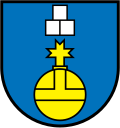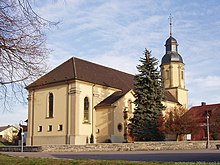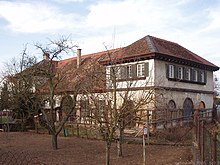Offenau
| coat of arms | Germany map | |
|---|---|---|

|
Coordinates: 49 ° 15 ' N , 9 ° 10' E |
|
| Basic data | ||
| State : | Baden-Württemberg | |
| Administrative region : | Stuttgart | |
| County : | Heilbronn | |
| Height : | 149 m above sea level NHN | |
| Area : | 5.65 km 2 | |
| Residents: | 2911 (December 31, 2018) | |
| Population density : | 515 inhabitants per km 2 | |
| Postal code : | 74254 | |
| Area code : | 07136 | |
| License plate : | HN | |
| Community key : | 08 1 25 079 | |
| LOCODE : | DE ONA | |
| Address of the municipal administration: |
Jagstfelder Strasse 1 74254 Offenau |
|
| Website : | ||
| Mayor : | Michael Folk ( SPD ) | |
| Location of the community Offenau in the district of Heilbronn | ||
Offenau is a municipality in the Heilbronn district in Baden-Württemberg . It belongs to the Heilbronn-Franconia region (until May 20, 2003 Franconia region ) and the peripheral zone of the European metropolitan region of Stuttgart .
geography
Geographical location
Offenau is located in the north of the Heilbronn district in the central Neckar valley, directly on the Neckar .
Neighboring communities
The neighboring cities of Offenau are ( clockwise , starting in the south): Bad Wimpfen , Bad Rappenau , Gundelsheim and Bad Friedrichshall , which all belong to the Heilbronn district. Offenau has entered into an agreed administrative partnership with Oedheim and Bad Friedrichshall .
Community structure
Apart from the Ziegelhütte residential area, Offenau has no other districts.
Division of space

According to data from the State Statistical Office , as of 2014.
history
On the occasion of a donation to the Lorsch Monastery , Offenau was first mentioned as "Offenheim" in 767 in a document from the Lorsch Codex . In the period that followed, Offenau was mentioned there nine more times. A brine spring on site was already used for healing purposes under the rule of the Teutonic Knight Order around 1560 . The Saline Clemenshall was founded in 1754, after which today's Altort was built as a workers' settlement and in 1790 the Linde spa hotel with bathing facilities and spa gardens . With the dissolution of the Teutonic Knight Order, Offenau, which until then belonged to the Deutschordensballei Franconia , became an independent municipality within the Kingdom of Württemberg in 1805 .
In the 19th century, the health resort helped the place to the Bad Offenau title and flourished in particular after the place received a train station in 1879. After the First World War , however, the spa business came to a standstill: the salt works were closed in 1929, most of the salt works were demolished in the 1960s, and the last remaining building burned down in 1981. The former saltworks area is now built over with the new town hall and the fire station. The only reminder of the saltworks is the salt store from 1780, located outside the former saltworks area.
From 1828 to 1936 , Clemenshall and the salt pans Ludwig ( Bad Rappenau ), Ludwigshall ( Bad Wimpfen ) and Friedrichshall ( Jagstfeld ) formed the salt sales cartel Neckarsalinenverein , the oldest and longest-running German sales cartel , to protect against their respective competitors . The Ziegelhütte residential area was also mentioned for the first time in 1828.
In 1939 there were 1038 inhabitants, at the end of 1945 there were 1201. In the course of the regional reform in Baden-Württemberg , Offenau was to be incorporated into the neighboring town of Bad Friedrichshall in 1973/74, but was able to avert this through intensive persuasion by the state government at the time .
After severe flood damage in 1993, 1995 and 1997, flood protection was built on the banks of the Neckar in Offenau between 2000 and 2003, consisting of an elevated, 2100 meter long protective dam and four pumping stations. The system, which cost almost 9 million euros, passed its first practical test before its official opening in spring 2004.
Religions
Offenau was a subsidiary of Duttenberg and belonged to the diocese of Worms . In 1438 it received its own parish with the parish church of St. Alban . Formerly part of the Teutonic Order, the place remained almost entirely Catholic until the 19th century. Protestants did not settle there until the salt works intensified, but initially did not form their own congregation, but attended church services in the surrounding towns. When many evangelical expellees came to Offenau after the Second World War, they built the Heilig-Geist-Kapelle , which is a branch of the parish in Bad Friedrichshall -Jagstfeld.
politics
Mayor of Offenau
- Ernst Walliser (1905–1941), mayor from 1930 to 1941
- Paul Weiß (1880–1956), acting mayor from 1941 to 1945
- Markus Pierro (1888–1967), mayor from 1945 to 1948
- Walter Wirsching (1919–2001), mayor from 1948 to 1981
- Johann Michl (SPD) (1953–1994), Mayor from 1981 to 1994 (died in office on December 24, 1994)
- Willi Schwenzer (* 1939), acting mayor 1994/1995
- Michael Folk (SPD) (* 1960), mayor since April 27, 1995
Municipal council
The community council in Offenau has 12 members. The local elections on May 25, 2014 led to the following official final result. The municipal council consists of the elected voluntary councilors and the mayor as chairman. The mayor is entitled to vote in the municipal council.
| Parties and constituencies |
% 2014 |
Seats 2014 |
% 2009 |
Seats 2009 |
||
| SPD | Social Democratic Party of Germany | 38.1 | 5 | 32.0 | 4th | |
| CDU | Christian Democratic Union of Germany | 37.2 | 4th | 35.6 | 4th | |
| FWV | Free electoral association | 24.7 | 3 | 32.4 | 4th | |
| total | 100.0 | 12 | 100.0 | 12 | ||
| voter turnout | 50.5% | 57.0% | ||||
badges and flags
The blazon of the Offenau coat of arms reads: In blue a golden orb, above it three (1: 2) silver cubes of salt. The flag of the municipality is yellow-blue.
The coat of arms has been used in this form by the municipality since 1939. The imperial orb appeared in Offenau's municipal seals since the beginning of the 20th century ; its significance for the place is not clear. In 1938, the Württemberg archives department determined the colors of the coat of arms and proposed the three salt cubes to distinguish them from similar coats of arms, which indicate the Offenau salt deposits and the Clemenshall saltworks. The coat of arms and the flag were awarded to the municipality by the Baden-Württemberg Ministry of the Interior on March 4, 1963.
Culture and sights
Buildings
- The Catholic parish church of St. Alban is a baroque building from 1751, built by Franz Häffele . The church has a baroque high altar by Kilian Hollbusch and an equally baroque pulpit. The other furnishings in the church (baptismal font, paintings, figures) are partly of more recent date. There is a Pietà in a niche on the outer wall .
- Former town hall from 1750.
- Baroque salt magazine from 1780.
- Former train station from 1879.
- Newly built Saline event center with Graf von Westerholt Chapel from 1892.
- In the historic town center, some interesting half-timbered buildings in the style of Franconian courtyards have been preserved.
Regular events
The Kornlupferfest is a special attraction in Offenau. It takes place on the penultimate weekend in July and is organized by the local associations in the Offenau Associations Working Group . From Saturday to Monday, the Kornlupfer celebrate their traditional festival, which conveys the village feel and agricultural origin to the visitor.
Economy and Infrastructure
Due to its convenient location, the place has a stable and balanced infrastructure with retailers, crafts, service providers and industry. In 1971 Südzucker AG settled in Offenau, whose factory for extracting sugar from sugar beet is the most important employer in the community today.
traffic
Offenau is on the railway line from Heidelberg to Bad Friedrichshall ( Neckartalbahn ). The S41 trams run to Mosbach and Heilbronn every hour . The federal road 27 cuts through the village and is consistently limited to ![]() km / h. The Neckar federal waterway has no port there.
km / h. The Neckar federal waterway has no port there.
media
The daily newspaper Heilbronner Voice reports on what is happening in Offenau in its issue N, District North.
education
The Volkshochschule Unterland has a branch in Offenau.
Personalities
Honorary citizen
- Walter Wirsching (1919–2001), Offenau Mayor from 1948 to 1981 (awarded 1985)
- Willi Röser (1922–2007), chairman and founder of the association, 1971 to 1989 member of the Offenau municipal council, (awarded in 1990)
- Alfred Erlewein (1935–2011), chairman and founder of the association, 1971 to 2009 member of the Offenau municipal council (awarded in 2009)
sons and daughters of the town
- Walter Ratzek (* 1960), 2012–2014 head of the Bundeswehr Music Corps
Individual evidence
- ↑ State Statistical Office Baden-Württemberg - Population by nationality and gender on December 31, 2018 (CSV file) ( help on this ).
-
^ Source for the section on community structure:
Das Land Baden-Württemberg. Official description by district and municipality. Volume IV: Stuttgart district, Franconian and East Württemberg regional associations. Kohlhammer, Stuttgart 1980, ISBN 3-17-005708-1 . Pp. 49-50 - ↑ State Statistical Office, area since 1988 according to actual use for Offenau.
- ↑ Minst, Karl Josef [transl.]: Lorscher Codex (Volume 4), Certificate 2429, April 26, 767 - Reg. 141. In: Heidelberg historical stocks - digital. Heidelberg University Library, p. 134 , accessed on January 22, 2018 .
- ↑ List of places for the Lorsch Codex, Offenau , Archivum Laureshamense - digital, Heidelberg University Library.
- ^ Museum in the Franconian Court , Bad Rappenau City Museum, Bürgerhaus
- ↑ https://www.leo-bw.de/web/guest/detail-gis/-/Detail/details/ORT/labw_ortslexikon/2164/Ziegelhütte+-+Wohnplatz
- ↑ Communications from the Württ. And Bad. State Statistical Office No. 1: Results of the population census on December 31, 1945 in Northern Württemberg
- ↑ Statistisches Landesamt Baden-Württemberg, municipal election results 2014 ( page no longer available , search in web archives ) Info: The link was automatically marked as defective. Please check the link according to the instructions and then remove this notice.
-
^ Sources for the section coat of arms and flag:
Heinz Bardua: The district and community coat of arms in the Stuttgart administrative region . Theiss, Stuttgart 1987, ISBN 3-8062-0801-8 (district and municipality coat of arms in Baden-Württemberg, 1). P. 112
Eberhard Gönner: Book of arms of the city and district of Heilbronn with a territorial history of this area . Archive Directorate Stuttgart, Stuttgart 1965 (Publications of the State Archive Administration Baden-Württemberg, 9). P. 129 - ↑ VHS Unterland branch offices .
literature
- Daniel Kress: Offenau. A representation of the community Offenau (district Heilbronn) in the past and present. Publisher: Offenau municipality. Geiger, Horb am Neckar 2010, ISBN 978-3-86595-357-5
Web links
- LEO-BW, discover regional studies online , Offenau

















